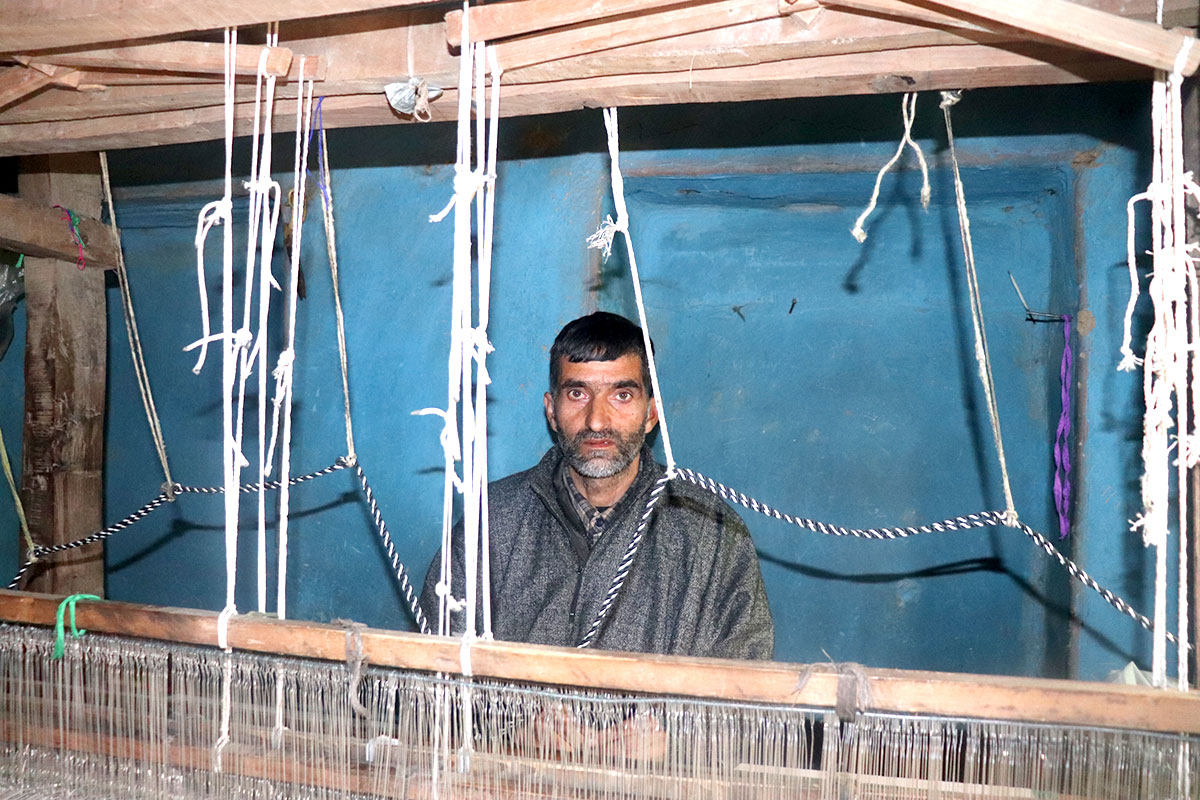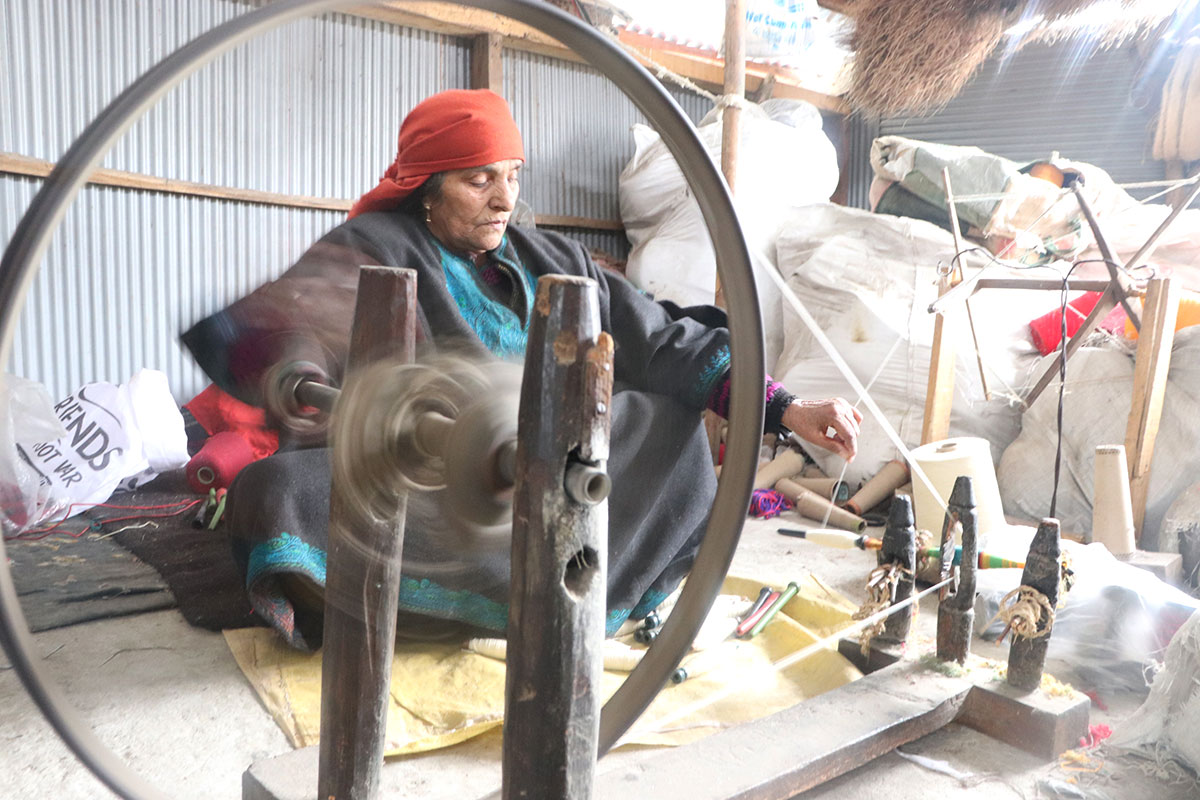Down south, a village has not abandoned handlooms because the power-looms work fast and better, but the weavers say they cannot change the destiny of a nosediving skill. They also want government reinvests in undoing the injustice they have been subjected to for decades, reports Samreena Nazir

For Khee Jogipora, a sleepy Kulgam village, the clackety chattering and screeching sound of the loom is the signature tune. Located almost 70 km south of Srinagar, deep in apple orchards, almost every family in the village owns a handloom, and at least one member of every family is associated with the weaving. The village is vital to Kashmir history because of Sheikh Nooruddin Noorani as the patron saint of Kashmir was born and brought up here.
Manzoor Ahmad Malik tries to straighten his back while his fingers and eyes are fixed on the loom over which he is working since Fajr prayers. He is proficiently weaving yarn into large sheets, which are then cut into a variety of products, strictly as per the fabric. It could be a shawl or a simple cloth or a base material for any other handicraft. Khee sees Manzoor as the village’s master-weaver because his family has been engaged in weaving for generations. So, many credits Malik and his family for tying the skill with the village’s life.
After shifting his residence to the concrete single-storey house, Manzoor has converted his old mud-brick house into his workshop. In one dimly-lit room, three looms are installed in a sequential manner for Manzoor and his brother Zahoor. The two brothers toil over these looms for the whole day. The first level of the old building houses the storage material: different varieties of thread are in one room; in the next room is a colourful treasure of different kinds of shawls, clothes, Dusoot, and other fabrics like tweeds for Pheran and winter coats.
Almost 30 years back, every individual in Khee would know one or the other handloom.“There were many clusters which would keep the whole village paired,” Manzoor’s mother Khateja Begum, 70, said while working on the spinning wheel and transforming hunk yarn to linear form. “Men used to work in clusters on looms and women would weave yarn on spinning wheels. The whole village would take evening tea sitting at one place and would equally deal with the work pressures of the seasonal months of June, July and August. During the seasonal peak, sometimes 2 to 3 people would operate from one loom.”
Manzoor, then a school going student, had hardly any interest in studies. He failed in his middles forcing his mother, Khatejah, to take him to Khee’s one of the finest weavers as an apprentice. Although his father was also associated with this skill, Khatejah wanted him to become a master weaver. Manzoors’s curiosity and the weaving environment of the village made him learn the art quickly.
“I was born into this, surrounded by weavers. I have known this art of weaving as long as I have known myself,” admits Manzoor. “This art was inherited by my father from my grandfather and by me from my father. Now I don’t have a son but I have taught this art to my daughters.” At 45, Manzoor is the third generation handloom weaver in the Malik clan.
Khee’s handloom weavers had created a society in 1997 namely MS Sharf. The society had more than 50 members and would produce kani shawls also. This society made the village famous when Kulgam chador became a popular handmade product. The chador has woollen texture and thermal qualities but its weaving style makes it different “During exhibitions, people take these chadors like hot cakes within and outside Kashmir,” Manzoor said.
Over the years, this art has suffered a lot and weavers bore the brunt for that. Since the advent of the power loom, this flourishing art started facing difficulties. Power looms are faster than handlooms, and with a larger variety of designs, when handloom weavers can produce 2-3 pieces in a day, a power loom produces more than 50 pieces a day. This witnessed the fall in the demand for these products. Khee weavers, however, did not dismantle the handlooms for the faster machines.
“Earlier we used to weave out of love for our work, but nowadays, it is a compulsion because we know no work other than weaving,” Abdul Aziz Malik, an old generation weaver said. “The entire village is in handloom weaving but the government has not even given even a shed because government schemes work only on papers.” Malik said despite being in the trade for decades, not a single weaver in the village has direct access to the market. “We do not have even a licence to market our own weave,” Malik said. “We are provided work by master weavers, who get the orders and yarn from the licensed weavers but do not work on looms. Almost there are 40 middlemen from Srinagar having direct access to the state and central markets.”
The production and marketing cycle is interesting. After getting the yarn from Srinagar weavers, the master weaver distributes it among local weavers. Once the weaving is over, the product is taken by the master weaver for dyeing, finishing and ironing – all in Srinagar. The produce finally lands in the lap of yarn supplier who uses the middlemen circuit for selling it. “Ours is a labour-intensive job but it fetches less money,” insisted Aziz. “We are not even paid in time.”
MS Sharf society which started with 50 members is now reduced to 13 members. Some of its founder members have abandoned their looms and are working as manual labours. “We are not able to compete with power looms,” Mohammad Younis, 38, who is now a carpenter, after abandoning a non-remunerative weaving job of 15 years. “I am the fourth-generation weaver. This is what I have done all my life, but I would never permit my kids to sit on a loom.”

Against the tide of handloom weaving decline and the problems the weavers face, a young weaver, Nelofar Jan, is sitting beside her father, Manzoor Ahmad Malik. She can easily operate a manual handloom. Nelofar loves and respects this art, which she has inherited from her ancestors. That is why she enrolled herself in shawl weaving trade at Industrial Training Institute, Anantnag and avoids any other degree she was otherwise capable of.
“The quality of handloom weaving items is more traditional and intimate but people are unable to distinguish between handloom products and power loom products,” Nelofer said. “People definitely value a handloom piece more than the ones made on electronic looms. We want government intervention to save this industry. If the government will help us in getting raw materials at subsidized costs, we can change the destiny of this craft.”















